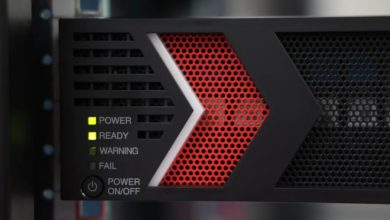IT Monitoring as a Way for Cooling Data Centres

Attributed to Felix Berndt, Regional Sales Manager of Asia Pacific, Paessler
 In an increasingly hyper-connected world, everything revolves around the consumption or generation of data. Skyrocketing data usage accelerated by the proliferation of data-reliant technologies such as 5G, artificial intelligence, and internet of things (IoT) and a digital lifestyle emanating from hybrid, remote working, online shopping, and digital content consumption has led to a spurt in data centers.
In an increasingly hyper-connected world, everything revolves around the consumption or generation of data. Skyrocketing data usage accelerated by the proliferation of data-reliant technologies such as 5G, artificial intelligence, and internet of things (IoT) and a digital lifestyle emanating from hybrid, remote working, online shopping, and digital content consumption has led to a spurt in data centers.
With our research showing that 55% of businesses in Singapore consider digital transformation their foremost priority in 2023, data centers are becoming a mission-critical aspect of every IT environment and vital for operational excellence. According to market research company Statista, the amount of data created, captured, copied, and consumed worldwide is expected to grow from around 59 zettabytes (ZB) in 2020 to around 149 ZB in 2024 – an exponential increase. Across the Southeast Asia region, the race is on to invest and expand in the growing data center market. As global tech giants such as Google, Facebook, Amazon, and Microsoft ramp up their data center operations across Southeast Asia (SEA), the region is fast emerging as a hotbed for data center players.
The Green Quotient
As per our research, 50% of businesses in Singapore have a sustainable IT strategy in place and are acting on it, and data centers are likely to be a crucial component of such a strategy considering the heat is quite literally on. Processing, storing, and managing the data requires significant use of energy, which has put the spotlight on sustainability. As data centers continue to increase in number, so will their energy demand as they house particularly power-hungry equipment that drive high performance and high availability mission-critical applications.
But does the data center or colocation provider have a sustainability strategy to get there while driving their business forward? Are their goals measurable? Are they exploring renewable energy or innovative technologies? Have they adopted sustainable measures across operations? These are vital questions that require attention.
Addressing the energy drain
One of the two primary drivers for energy consumption within a data center is running the IT equipment itself. Within a typical data center, there are many types of technical equipment, virtually all of which run on electricity. This includes power-intensive equipment such as servers, storage systems, large-scale infrastructure such as backup generators and power subsystems, as well as computers, routers, applications, software, data traffic, and services. These equipment are often tightly packed into a facility and need to run 24/7 in order to process the massive amounts of data stored within. This, in turn, generates large amounts of heat from the IT equipment.
In order to prevent overheating and avoid damage, data centers need to be maintained within a very narrow temperature band throughout the course of its operation. And here is where another major energy consumer comes in – the cooling system.
Data centers need an enormous amount of power to operate a cooling system as it maintains ventilation, temperature and humidity levels, and supports all in-house equipment. Data centers today are adopting sustainable measures to minimize their dependency on a traditional cooling system; in fact, our research showed that 82% of data centers have a sustainable IT strategy in place.
Some players are building their data centers high in the mountains to leverage the cold temperature. For instance, Microsoft is experimenting with an underwater data center ‘Project Natick’ off the coast of Scotland’s Orkney Islands. However, a tropical region like SEA neither has constant cold wind nor is surrounded by cold water sources, and hence, strongly relies on a power-operated cooling system. In such a scenario, data centers should focus on improving water utilization to optimize power usage.
Monitoring to the Rescue
90% of businesses in ASEAN see the benefit of real-time IT infrastructure monitoring while 81% businesses in Singapore foresee real-time monitoring as a way to optimize energy consumption. The foundation of evaluating the energy efficiency of a data center lies in the ability to quantify energy efficiency. Without measuring a data center’s energy consumption, it is not possible to track the baseline, progress, and identify opportunities to optimize energy efficiency.
One way to measure energy consumption is through power distribution units (PDUs). PDUs distribute and control electric power, especially to the various racks and cabinets present within a data center. However, advanced PDUs have remote monitoring functionality, through which operators can track, log, and review real-time data such as power consumption, distribution, fluctuations, uptime, load level, etc. When PDUs are integrated with a monitoring solution that consistently measures and records energy consumption, it helps data centers have a real-time overview of energy usage across their entire IT infrastructure.
This includes the ability to comprehensively monitor all constituents of a data center which includes both technical and operational essentials such as cooling and power systems across multiple locations. In all, combining the data output from a PDU with a holistic monitoring solution leaves data centers in a much better position to detect energy hogs, identify irregularities, monitor trends, and improve energy efficiency planning. It helps data centers make informed decisions to manage their overall use of power and optimize business costs.
While there is an incessant demand for data consumption, managing energy utilization in a sustainable way is the future of the data center industry. But the challenges are more diverse and widespread. Operational challenges such as supply chain disruptions, balancing cost and efficiency, capacity management, rising energy costs, and security concerns, are compounded by businesses perceiving digital transformation and sustainability in silos. In such a scenario, there is an increasing expectation for environmental sustainability in the data center business. However, an individual, government, company, or industry cannot solve this. Sustainability requires a holistic approach and hinges on participation from every stakeholder.




